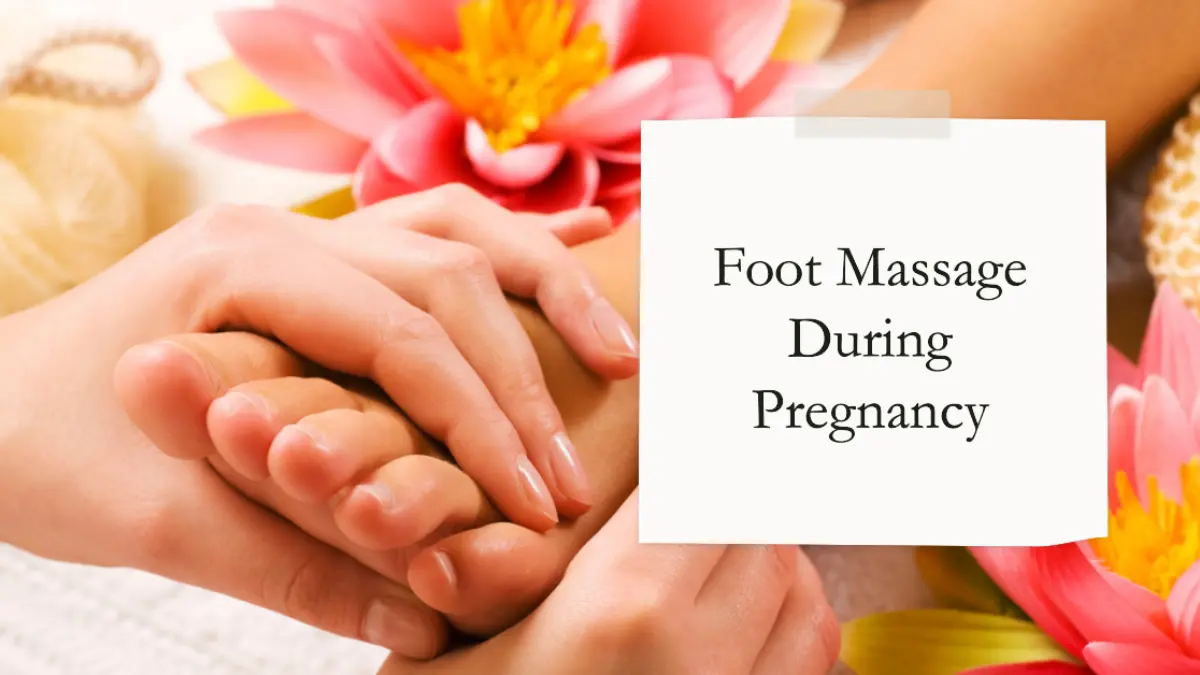
Ah, the miracle of pregnancy! It’s a time of joy, excitement, and, let’s face it, a few challenges. As your body goes through incredible changes, taking care of yourself becomes a top priority. Now, we all know that a relaxing foot massage can work wonders, but during pregnancy, there are some spots that need a little extra TLC. So, put your feet up, grab a comfy seat, and join us on a journey to discover where to avoid foot massage during this incredible adventure. We’ll explore the do’s and don’ts, the hotspots and notspots, and ensure you and your little bundle of joy stay safe and sound. Get ready for a fun and informative ride as we unveil the secrets of where to avoid foot massage during pregnancy. Let’s kick off this exciting exploration, shall we?
Related: Why to avoid Banana during Pregnancy?
Understanding the Importance of Safe Foot Massage during Pregnancy
During pregnancy, the body goes through numerous changes, and many women experience discomforts such as swelling, aching feet, and muscle tension. It’s natural for expectant mothers to seek relief from these symptoms, and foot massage is often considered as an option. However, it is essential to understand the importance of safe foot massage during pregnancy to prevent any potential harm to both the mother and the baby.
Pregnancy causes several physiological changes in the body, including hormonal fluctuations, increased blood volume, and changes in blood circulation. Foot massage can affect these changes by stimulating certain pressure points, which may induce labor or trigger unwanted complications. It is crucial to be cautious and avoid unnecessary risks during this delicate period.
Potential Risks of Foot Massage during Pregnancy
While foot massage can be beneficial for many individuals, it can pose certain risks when performed during pregnancy. One of the primary concerns is the stimulation of pressure points that are linked to reproductive organs and may potentially lead to contractions or premature labor. It is advised to avoid excessive or intense pressure on these areas to prevent any unwanted consequences.
Furthermore, some essential oils or aromatic substances used in foot massage can have adverse effects on pregnant women. Certain oils may cause allergic reactions or even be harmful to the developing baby. It is always recommended to consult with a healthcare professional before using any products during
pregnancy, including oils and lotions for foot massage.
Where to avoid Foot Massage during Pregnancy?
Certain pressure points on the feet are believed to have a stimulating effect on the uterus and reproductive organs. During pregnancy, it is essential to avoid these pressure points to minimize the risk of triggering contractions or other complications. Some of the pressure points that should be avoided during foot massage include:
- The inside of the ankle: This area is connected to the uterus and should be avoided to prevent any potential stimulation of contractions.
- The area between the ankle bone and heel: Massaging this area can stimulate the pelvic region, which is best avoided during pregnancy.
- The inner and outer edges of the heel: These areas are linked to the ovaries and should be avoided to prevent any unwanted effects on reproductive organs.
- The webbing between the big toe and second toe: Massaging this area may lead to uterine contractions and should be avoided.
- The area around the ankle bone: This region contains sensitive nerves that, when stimulated, can affect the uterus and potentially lead to complications.
It’s important to communicate with your massage therapist about your pregnancy and ensure they are aware of the areas to avoid during the session.
Alternative Relaxation Techniques for Pregnant Women
While foot massage may not be recommended during pregnancy, there are several safe and effective alternative relaxation techniques that can provide relief from common discomforts. These techniques focus on relaxation and soothing the body without involving pressure on specific points that may pose risks. Here are some alternatives for pregnant women to explore:
- Foot Soaks: Soaking your feet in warm water can help reduce swelling and provide relaxation. Add a few drops of essential oils, such as lavender or chamomile, for added soothing benefits.
- Foot Compression: Using compression socks or stockings can help improve circulation and alleviate swelling in the feet and legs. It’s advisable to consult with your healthcare provider to determine the appropriate level of compression.
- Gentle Foot Massage: Instead of deep pressure and specific points, opt for a gentle and general foot massage. Use long, sweeping strokes and focus on providing overall relaxation rather than targeting specific areas.
- Prenatal Yoga: Participating in prenatal yoga classes can help improve flexibility, reduce muscle tension, and promote relaxation. Be sure to inform your instructor about your pregnancy to ensure modifications are made to accommodate your needs.
- Meditation and Breathing Exercises: Practicing meditation and deep breathing techniques can help calm the mind, reduce stress, and promote overall relaxation. Find a quiet space, sit comfortably, and focus on your breath.
Remember, always consult with your healthcare provider before trying any new relaxation techniques during pregnancy to ensure they are safe for you and your baby.
Professional Guidance for Prenatal Foot Massage
If you are considering getting a foot massage during pregnancy, it’s crucial to seek professional guidance from a trained prenatal massage therapist. These professionals have the knowledge and experience to provide safe and effective massage techniques for pregnant women. When selecting a massage therapist, consider the following:
- Certification and Training: Ensure that the massage therapist is specifically certified in prenatal massage techniques. This certification ensures they have received proper training in addressing the unique needs and considerations of pregnant women.
- Experience: Inquire about the therapist’s experience working with pregnant clients. An experienced therapist will be familiar with the precautions and adjustments necessary to provide a safe and comfortable massage.
- Communication: Choose a therapist who actively communicates and listens to your concerns. They should be receptive to your feedback and adjust the massage accordingly to ensure your comfort and safety.
- Health History Evaluation: A reputable prenatal massage therapist will conduct a thorough evaluation of your health history and any pregnancy-related conditions before proceeding with the massage. This assessment will help them understand any specific considerations or precautions that need to be taken during the massage.
- Positioning and Support: Prenatal massage typically involves positioning the pregnant woman in a side-lying or semi-reclining position to ensure comfort and safety. The therapist should provide appropriate support with pillows or bolsters to alleviate pressure on the abdomen and ensure proper alignment of the spine.
- Open Communication with Healthcare Provider: It is essential for the massage therapist to have open communication with your healthcare provider. They should be willing to collaborate and consult with your doctor or midwife to ensure that the massage is suitable for your individual needs and any specific pregnancy-related conditions.
By seeking professional guidance, you can enjoy the benefits of a foot massage during pregnancy while minimizing the potential risks.
Precautions and Safety Measures during Pregnancy
In addition to avoiding foot massage in certain areas and seeking professional guidance, there are other precautions and safety measures that pregnant women should consider:
- Timing: It is generally recommended to wait until the second trimester before receiving a foot massage. This is because the first trimester is a critical period of fetal development, and it’s best to err on the side of caution during this time.
- Communication: Always inform your massage therapist about your pregnancy and any specific concerns or discomforts you may be experiencing. This will help them tailor the massage to your needs and ensure your safety.
- Hydration: Drink plenty of water before and after the massage to stay hydrated and flush out toxins.
- Comfortable Environment: Choose a calm and relaxing environment for your massage session. Dim lighting, soothing music, and a comfortable temperature can enhance the overall experience.
- Listen to Your Body: Pay attention to how your body feels during the massage. If something feels uncomfortable or painful, let your therapist know immediately. Remember, the goal is to promote relaxation and alleviate discomfort, not to endure unnecessary pain.
Always prioritize your safety and well-being during pregnancy. If you have any concerns or doubts about receiving a foot massage, it’s best to consult with your healthcare provider for personalized advice.
Benefits of Foot Massage for Pregnant Women
While there are areas and techniques to avoid, it’s worth noting that foot massage, when performed safely and appropriately, can offer several benefits for pregnant women. Some potential benefits include:
- Stress Relief: Pregnancy can be a physically and emotionally demanding time. Foot massage can help reduce stress, promote relaxation, and improve overall well-being.
- Edema Reduction: Swelling in the feet and ankles, known as edema, is a common discomfort during pregnancy. Gentle foot massage and elevation can help alleviate this swelling and improve circulation.
- Pain Relief: Pregnancy often brings about aches and pains, especially in the lower back, hips, and feet. Targeted massage techniques can help relieve muscle tension, reduce pain, and enhance comfort.
- Improved Sleep: Many pregnant women struggle with sleep disturbances. Foot massage before bedtime can promote relaxation, improve sleep quality, and alleviate insomnia.
- Hormonal Balance: Foot massage has been known to stimulate the release of endorphins, which are natural mood-boosting hormones. This can help balance hormones during pregnancy and contribute to a more positive emotional state.
Remember that individual experiences may vary, and it’s essential to listen to your body’s unique needs and consult with your healthcare provider before incorporating foot massage into your pregnancy routine.
Recommended Foot Massage Techniques for Pregnancy
When performing a foot massage during pregnancy, it’s crucial to use gentle techniques that provide relaxation and avoid areas with potential risks. Here are some recommended foot massage techniques for pregnant women:
- Gentle Stroking: Use your hands to stroke the entire foot, starting from the toes and moving towards the ankle. Apply light pressure and use long, fluid movements to promote relaxation and improve circulation.
- Thumb Circles: Use your thumb to make circular motions on the soles of the feet. Focus on applying gentle pressure to areas that feel tense or sore. Avoid pressing on sensitive pressure points.
- Arch Massage: Place one hand on the top of the foot and use your other hand to support the heel. Use your thumbs to massage along the arch of the foot in a back-and-forth motion. This can help alleviate discomfort and tension in the arch area.
- Ankle Rotations: Hold the foot with both hands and gently rotate the ankle in a circular motion. Start with small circles and gradually increase the size. This technique can help relieve ankle stiffness and improve flexibility.
- Toe Stretching: Hold the base of each toe and gently pull it forward and backward to stretch the muscles and joints. Be careful not to apply too much force or strain the toes.
Remember to always communicate with the person receiving the foot massage and adjust the pressure and techniques based on their comfort level. It’s important to prioritize their safety and well-being throughout the massage.
Relaxation Methods for Common Pregnancy Discomforts
Pregnancy can bring about various discomforts, but there are relaxation methods that can help alleviate these issues. Here are some techniques to address common pregnancy discomforts:
- Swollen Feet and Ankles: Elevate your legs and feet whenever possible to reduce swelling. Use cold compresses or soak your feet in cool water with Epsom salt to provide relief.
- Lower Back Pain: Practice gentle stretching exercises that specifically target the lower back area. Use heat packs or take warm baths to relax the muscles. Consider using a pregnancy support pillow or belt for added comfort and support.
- Leg Cramps: Stretch and massage your calf muscles regularly. Apply heat or use a heating pad to relax the muscles. Ensure you are getting enough hydration and include foods rich in magnesium and potassium in your diet.
- Fatigue: Take short breaks throughout the day to rest and relax. Incorporate relaxation techniques such as deep breathing and meditation to reduce stress and boost energy levels.
- Acid Reflux and Heartburn: Eat smaller, more frequent meals and avoid consuming spicy or greasy foods. Sleep with your upper body slightly elevated to reduce symptoms.
Remember to consult with your healthcare provider for personalized advice on managing specific discomforts during pregnancy. They can provide guidance tailored to your individual needs and ensure that the relaxation methods you choose are safe for you and your baby.
Self-Care Tips for a Healthy and Comfortable Pregnancy Journey
In addition to relaxation techniques and avoiding certain foot massage areas, practicing self-care is essential for a healthy and comfortable pregnancy journey. Here are some self-care tips to consider:
- Maintain a Balanced Diet: Eat nutritious meals that provide essential vitamins, minerals, and nutrients for you and your baby’s health. Include plenty of fruits, vegetables, whole grains, lean proteins, and healthy fats in your diet.
- Stay Active: Engage in regular physical activity that is suitable for pregnancy, such as walking, swimming, or prenatal yoga. Consult with your healthcare provider before starting any exercise routine.
- Get Sufficient Rest: Prioritize sleep and ensure you are getting enough rest. Take short naps during the day if needed and establish a bedtime routine that promotes relaxation.
- Hydrate: Drink an adequate amount of water throughout the day to stay hydrated. Proper hydration can help prevent swelling, regulate body temperature, and support overall well-being.
- Seek Emotional Support: Pregnancy can bring about a range of emotions. Reach out to your partner, family, and friends for support. Consider joining support groups or seeking professional counseling if needed.
- Pamper Yourself: Take time for yourself and indulge in activities that bring you joy and relaxation. This could include taking warm baths, getting a prenatal massage from a certified therapist, practicing gentle yoga or stretching, or enjoying a hobby you love.
- Prioritize Mental Well-being: Take steps to manage stress and prioritize your mental health. This can include practicing mindfulness and meditation, journaling your thoughts and feelings, or engaging in activities that promote a positive mindset.
- Regular Prenatal Check-ups: Attend all scheduled prenatal check-ups with your healthcare provider. These appointments are crucial for monitoring your health and the well-being of your baby. Address any concerns or questions you may have during these visits.
- Educate Yourself: Take the time to educate yourself about pregnancy, childbirth, and newborn care. Attend prenatal classes or workshops to gain knowledge and prepare for the arrival of your baby.
- Connect with Other Expectant Parents: Joining prenatal or parenting groups can provide a sense of community and allow you to connect with other expectant parents. Sharing experiences, tips, and concerns can be both comforting and informative.
Remember, each pregnancy journey is unique, and it’s important to listen to your body, follow the guidance of your healthcare provider, and prioritize self-care throughout the process.
Related: Why to avoid Banana during Pregnancy?
Frequently Asked Questions (FAQs)
Is foot massage completely off-limits during pregnancy?
No, foot massage is not completely off-limits during pregnancy. However, it is important to avoid certain pressure points and seek professional guidance from a trained prenatal massage therapist.
Are there any specific oils or lotions that should be avoided during foot massage?
It is recommended to avoid essential oils and lotions that are not pregnancy-safe. Consult with your healthcare provider or massage therapist for suitable options.
Can foot massage induce labor?
Certain pressure points on the feet are believed to have stimulating effects on the uterus. To minimize the risk of triggering contractions, it is best to avoid these pressure points during foot massage.
When is the best time during pregnancy to receive a foot massage?
It is generally recommended to wait until the second trimester before receiving a foot massage. However, always consult with your healthcare provider for personalized advice.
Can foot massage help with swelling in the feet and ankles?
Yes, gentle foot massage and elevation can help reduce swelling and improve circulation in the feet and ankles.
Are there any risks associated with foot massage during pregnancy?
When performed safely and with the guidance of a trained prenatal massage therapist, foot massage is generally considered safe. However, it’s important to communicate any concerns or discomforts with your healthcare provider.
Can I perform self-foot massage during pregnancy?
Yes, you can perform self-foot massage during pregnancy using gentle techniques and avoiding sensitive pressure points. However, it’s recommended to seek professional guidance for a more targeted and safe experience.
How often can I receive a foot massage during pregnancy?
The frequency of foot massages during pregnancy may vary. It’s best to consult with a prenatal massage therapist to determine a suitable schedule based on your individual needs and health.
Are there any other relaxation techniques I can try besides foot massage?
Yes, there are several alternative relaxation techniques for pregnant women, including foot soaks, foot compression, gentle foot massage, prenatal yoga, and meditation.












